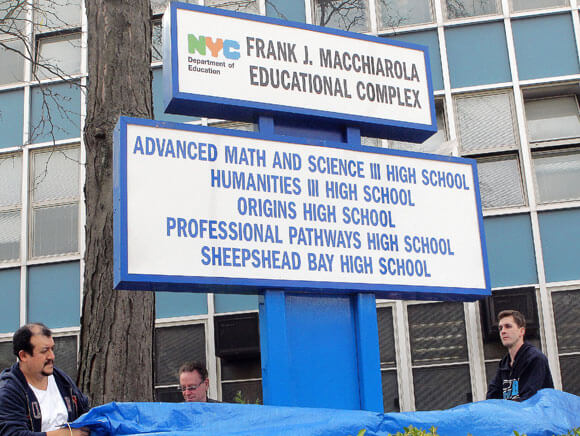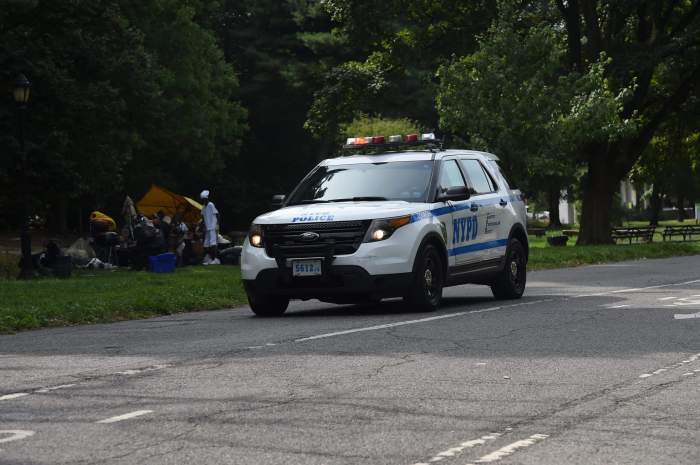The ongoing strain between New York City’s public school and charter school communities took another turn late last month when the United Federation of Teachers, along with parents and individual teachers, filed a lawsuit in Manhattan Supreme Court against the Department of Education for allegedly violating state education law and its own regulations when it chose to allow Success Academy, the city’s largest charter school network, to co-locate two of its schools into buildings in Queens and Sheepshead Bay, Brooklyn.
Even so, there have been many lawsuits over the years against charter schools in hopes of preventing them from co-locating in Manhattan, The Bronx, Queens, and Brooklyn. Success Academy has seen 20 such cases since 2011, though none were successful.
This most recent lawsuit was filed after the DOE announced its plan to co-locate a Success Academy school at the Frank J. Macchiarola Educational Complex, and points to the new Class Size Law, which was signed by Gov. Kathy Hochul in September.
Co-location and class size caps
The law implemented a new class size cap for the city’s public school classrooms; charter schools are not bound by those caps. According to the suit, “The DOE has misled parents, the public, and the PEP itself regarding the actual impacts of its proposed co-locations, including both schools’ ability to comply with impending requirements of the new Class Size Law.”
“The whole process of how to co-locate a school is something we’ve always completely disagreed with,” said UFT President Michael Mulgrew. “It’s basically like the DOE waving a wand and saying it’s OK, and you can do whatever you want and that is something we don’t agree with.”
The Class Size Law requires the city to shrink classroom sizes by 20% each year until 2028, and they must send an annual report detailing their progress to the state each year. schools are reducing the number of students in the classrooms over a five-year period before they reach new cap sizes. He said the DOE did not take that into consideration at all during its site analysis of at the Educational Complex.

“We just felt like we want to hear from the courts,” Mulgrew said. “We feel strongly that there is a law that says the City of New York must lower its class sizes and have a plan in compliance within five years, and right off the bat in the first year the Department of Ed ignored that when it was doing co-locations. And we feel strongly that it should be part of this process.”
Joining the suit is Advocates for Justice, a public interest law firm that provides pro bono or low-cost representation for education issues throughout the five boroughs. The Class Size Law is what drew Advocates for Justice to this case, especially in regard to the allegations that the law is not being considered in this co-location plan.
“And in this particular case, the education impact statements and the building utilization plan are essentially silent as to the effect of this co-location on the current class sizes and class configuration, then it is going to increase and make [it] more difficult the ability to comply with the law,” said special counsel Laura D. Barbieri. “Because it is not going to allow the law to take effect. The DOE says don’t worry about it, we’re going to comply within the time frame. But they’re creating a situation where it is impossible to comply.”
Barbieri said the DOE could eventually request a waiver for the class size requirement since they would not be able to comply, even though complying with the law could have been done from the beginning.
“The building utilization plan refers to the underlying plan that is the blueprint that the Board of Education uses for every school,” Barbieri said. “And that blueprint is flawed, in my opinion, because it’s old. It presupposes that nothing is going to change in terms of class sizes. It says it’s not going to have any effect on classes and that the classes are going to be the same size going [forward.] And that’s just not true.”
Another plaintiff in the suit is Elizabeth Weinert, a teacher and union chapter leader at Professional Pathways High School, a transfer school located at the Macchiarola Educational Complex. Both Weinert and Mulgrew said the teachers and parents of the students in the complex are not pleased with the idea of co-locating with Success Academy. That’s also in part because the charter school is aiming to place an elementary school on the top floor of the building, while the three other schools are either high schools or offer adult education programs. Even the available space in the building formerly belonged to a high school, New Visions Charter High School for Humanities III.
“When New Visions closed because of low enrollment, we knew it was going to be something,” Weinert says. “But when we learned it would be an elementary school from Success Academy, eyes got really wide. This has been a high school space since the ‘60s.”
‘We’re not equipped for little kids’
Even Curtis, the football coach for all three high schools at the building who asked his last name be withheld, said it was “shocking” to learn a Success Academy elementary school was coming to the complex, especially after initially thinking the available space would be used by the current schools after the class size law passed.
“My first reaction was, that’s going to be very difficult for that small amount of space,” he said. “It wasn’t until going to that first PEP meeting that I understood that it was going to be 200-plus kids next year. When I heard that number, that was when I became concerned for safety.”
Curtis said there are safety concerns, including both the high and elementary students sharing the same stairwell during fire drills. There is also the concern about the size of the bathroom facilities, since the older students would be sharing bathrooms with the older students, who are much taller.
“It really is a very strange decision to put little ones in that predicament,” Curtis says. “I feel it opens up issues for my students who are here. The building was made for older students.”
As for Weinert, she said children as young as six would be walking in halls or in stairwells alongside other students as old as 20, with adult education students as old as 40 in classrooms down the hall. In addition, she said high school students can be “silly and mischievous” and not worry about any six-year-olds nearby.
However, there are other high schools and elementary schools co-locating throughout the city. Although Weinert says it is not up to her and the staff members in the building to determine if those co-locations worked or not, the issue with this matter is that the plan the DOE presented gave no specifics on how elementary-age children and older students were going to share this building.
“They just say the safety committee would figure it out,” Weinert said. “They basically put it on the building, so it’s up to us and we have no guide. We’re not equipped for little kids.”
She said that during joint public hearings, representatives from Success Academy said everything would work out since it worked elsewhere, and all the schools can work together. They suggested a buddy system where the high school and elementary students would be paired up. Although Weinert thinks that could help, she says there are still many questions being asked regarding safety, and the lack of transparency is fueling the lawsuit.
According to the Educational Impact Statement, these community inputs include a meeting with Community Education Council 22 on October 11, 2022. The School Leadership Teams for the three schools held meetings discussing this co-location shortly thereafter, and more meetings featuring local elected leaders, including Borough President Antonio Reynoso, were held in early November. A PEP meeting was held via telecommunication in December in which parents and staff from Success Academy and the three schools at the Macchiarola Education Complex gave their views on the co-location. The PEP voted in favor of it at the end of the meeting.
The DOE further explained that the Macchiarola Educational Complex proposal ensures that all schools have sufficient space to adhere to class-size maximums and protect student safety and provides “intentional plans for the use of space” by every school in the complex.
“We have had a lot of experience with this and have had safe and amicable sharing arrangements with dozens of schools, including high schools, over the past decade and a half,” a Success Academy spokesperson said. “In our experience, the Building Council – members of all the schools in the building – work out the schedule for shared spaces (stairwells, cafeterias, etc.). Co-locations do not mix student bodies – each school has designated hallways, floors, bathrooms.”
When asked about the lawsuit, Success Academy’s Chief Public Affairs Office Ann Powell simply said, “The UFT and their allies have tried to sue 20 times before to prevent Success Academy co-locations and have never been successful because they are without merit.”
Nathaniel Styer, a DOE spokesperson, said “We work hard to provide parents, staff, the Panel for Education Policy, and the community with thorough information on the proposals and the best information available to us on potential impact of any co-location. We provided all the information state law requires to both the public and the Panel in advance of the vote.”
Past and future fights against Success Academy
Brooklyn parents have fought Success Academy co-locations in public schools in years past — in 2013, families rallied unsuccessfully against a co-location at Roy H. Mann middle school in Bergen Beach. Two years later, angry parents demanded the school be banned from opening new locations after it was reported that Success Academy faculty had used harsh punishments on students at its Fort Greene location.
As of April 14, the lawsuit is still active. Barbieri said lawsuits can be like a mediation, where the meeting allows a chance for the two teams to open their minds to the possibility of other solutions besides theirs. She hopes the same can happen with this case.
“I am always willing and hopefully able to talk to an adversary to get a meeting of the minds,” Barbieri said. “Generally, [Success Academy’s] standard line is the suit has no merit. If they are willing to come to the table, absolutely.”

Mulgrew says he had hoped the lawsuit would not happen. He also says the timeliness of this case is very important with the school planning taking place in DOE schools right now.
“The planning for the schools starts now for September,” he said. “So that is what we will be arguing in court that we need to expedite this, and see if the court will agree and allow us to expedite. We’ll do it as fast as possible.”
Weinert’s hope is for a quick outcome and by September, something in the building that will actually serve the young adults she teaches.
“We do have the space, so there’s rooms for students,” she says. “We would like it to have that reflect the needs of our neighborhood, which we really feel in this process…we really feel that the community has been ignored. We would love to see our voices heard and something in place in September that will make sense and help our students.”
Correction & Clarification, 4/15/2023, 2:45pm: This story previously misstated the outcome of lawsuits against co-location proposals, and has been updated with additional information regarding the Educational Impact Statement.






















